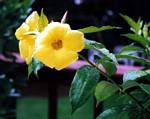

Plants are a renewable natural resource. Nature has conferred the capability of growth and development on these resources. Therefore, if they are utilized, they are regenerated. For example millions of people continue to utilize plants directly or indirectly in their daily life but due to the character of plant growth and development, there is no sign of total disappearance of these species. The utility of the plant products range from the kitchen, bedroom, office, domestic and even international markets.
Besides this, the natural beauty of our environment can never be imagined excluding the component of plants. Moreover, these small tiny herbaceous species, shrubs and huge trees provide nests, shelters and food for innumerable birds, insects and animals. The most precious and continuous gift of the plants for the entire humanity is the oxygen gas, which is designated by the chemist community by the name of oxygen. If the plants cease to exist, the entire life over the globe will come to a stand still. Thus, the crying need for biodiversity.
The world population is increasing incrementally and proportionately the utility of these resources will also multiply. Therefore, the responsibility of plant scientists is to explore the innumerable natural resources for the fulfillment of the basic needs of the living beings, so that the problem of food and shelter could be easily resolved. During the last decade, the prices of drugs have become so expensive that it is really beyond the purchasing power of an ordinary citizen. Therefore, the people are going back in time for their treatment through the natural plant resource of inexpensive drugs, and without harmful side effects. Therefore it’s the need of the day to explore and investigate the medicinal potential of the wild plants growing in our surroundings to provide treatment to the suffering humanity.
The people are used to the few known plants such as flowers, fruits, vegetables and crops. Millions of wild plants growing in diverse habitats ranging from sea, to the terrestrial habitats are normally graded as useless. But it has been confirmed that each and every specie is useful - a treasure of unlimited medicinal ingredients that could be prescribed for diverse diseases. It would be better to explain this fact by quoting a few examples. The plants of Taxus species grow in the mountains and are used as fuel locally. Now Taxol has been extracted from this species and is an anticancer drug. Solanum nigrum is a weed growing wildly in the crops. The farmers get rid of these weeds by pulling out manually or using weedicide. Experts are of the opinion that if the Solanum nigrum is included in the kitchen as a vegetable, the immunity in the human body against hepatitis could be strengthened.
The farmers cultivate maize crop (Zea mays) every year on seasonal basis. This crop needs plenty of water. Moreover, this is resistant to seven diseases all over the world. The Botanical students of California University collected plants during their routine field study trip. But later, on they discovered a new species and the Taxonomist designated this new taxon to be Zea dipploperrenes. Further exploration revealed that this specie is perennial, resistant to the seven diseases of the cultivated maize crop and can be grown in regions with comparatively less water.
During the present era, it has been possible that genes could be transferred from one species to another allied species. Let us suppose if the required genes from the wild maize could be transferred to the cultivated maize. What will happen? The hypothetical species of maize evolved from wild X cultivated will possess the following characters. This crop of maize will be perennial. Its cultivation range will be increased. It will be resistant to seven known diseases. The productivity will be enhanced. There will be tremendous savings by cutting short annual cultivation budget, and omitting the interval research experimentation expenditures for revival of the hybrid vigor.
During this moment explaining the importance of plant natural resources, the saying of Almighty Allah came to my mind i.e. “I have not created all these useless.” And says in another ayah. “Your knowledge is limited.” These statements reveal that every created natural resource is of immense importance but needs exploration, investigation and looking for its proper utilization for the betterment of the humanity.
The importance of genes present in plants and animals was realized in the biodiversity meeting held by the UN and steps were taken for the conservation of these natural resources, as the human behavior towards them is extremely deplorable. Some of the plant communities are destroyed for the purposes of construction/development works and agricultural practices, while on the other side the entire forests are leveled to the ground for a financial benefit.
The entire scenario can be visualized by the fact that the forests which hinder the free flow of rain water and reach the rivers and springs through their root system, besides endowing a scenic beauty to the valleys, now due to the lack of forests run off the mud with rain water and turns into floods, which are causing tremendous damage to the settlements, agriculture, crops and silting the reservoirs in the dams. These events are the sole cause of water and energy crises.
Sixteenth International Botanical Congress was held in St. Louis, Missouri, U.S.A. in August 1999. Five thousand participants poured into the avenue from all over the world. The experts expressed their concern about the endangered state of affairs about biodiversity and the plant life globally and presented a resolution. They were of the opinion that two thirds of the entire flora of the world was likely to get to the verge of extinction during the 21st century. It will automatically curtail all the ongoing endeavors for the exploitation of plant natural resources for the welfare of human beings. They called on the world community for assigning priority to the Plant Conservation on their agenda.
For follow up of the same issue another meeting of 14 members was held in Gran Canaria, Spain, in April 2000. They demanded the member countries that serious steps should be adopted under the clause of United Nations Convention on Biological Diversity for the Plant Conservation and stressed for this purpose a Global Strategy for Plant Conservation so that all the obstacles hindering the healthy plant life could be eradicated.
It is the moral duty of all nations to adopt such strategies to ensure a safe and sound environment for the plants and animals, so that they can grow and propagate well, because they are a real treasure for the present and future generations.
The following steps are considered to be necessary for this sacred task in addition to the other modalities.
1. Community awareness and involvement
The plants have been the focal point since the birth of human being and numerous books, journals, manuals, revisions and monographs can be observed in the shelves of libraries. There are always seminars and research oriented discussions in the educational institutions. But the plants grow in diverse habitats of far-flung areas, mountains, forests and deserts. There is no security system for these plants. The only strategy for this particular purpose could be visualized only through community awareness, so that they could be alerted, realize them the gravity of the problem and turn their attitude friendly towards plants. For this purpose, the government should adopt such a mechanism that the community could be involved and be rewarded in return. These steps will realize them the sense of ownership over the assets.
2. Base line information/Species inventory/Plant Biodiversity Exploration
Going through all the disciplines in sciences and humanities, one can come to the conclusion that each and every discipline is the compilation of names. When a baby is born, the parents designate him/her with a name. Every plant is assigned a Japanese name in Japan. But it is very strange that almost all plants are without names in the spoken languages. One cannot imagine the assets without names. The first attempt was made towards this during the compilation work of the Pashto dictionary-Dariab (1994). They introduced the available Pashto names of plants and tried to assign them with botanical names. This work could be taken as a model for other regional languages for introduction of the local names of the plants in various languages.
Therefore serious steps should be taken for the exploration of the natural wealth that is normally known by species inventory or baseline information or plant biodiversity exploration. For this particular purpose, the country should have Herbaria in all the state run universities and at least in each Degree college at the District Headquarters. This will provide a golden opportunity for the students and researchers and can be a positive step for the documentation of the natural resources for the future planners of the country.
3. Development of the human natural resource in the discipline of Plant Taxonomy
There is no disagreement as far as community awareness, involvement and discovery of the plant natural resources are concerned. The world is rich in possession of millions of natural plant resources. But the experts in the related fields all over the world can be counted at fingertips. Howsoever elaborate the objectives of plant conservation; it will never be substantiated without properly trained skilled persons in the discipline of Plant Taxonomy. The plants are the natural pharmaceutical factories. Each species is specialized for the manufacturing of a particular set of compounds.
Without knowing the exact name of the species, how can one coin perfectly, the findings of the research, with the species for the information of the people concerned in the same field? Really it is a hard and tedious job. You are putting a lot of your precious time and energies but coming up with meager information.
Therefore, there is urgency for the training and periodic refresher courses to be arranged for the teachers and researchers in perspective of the envisioned Plant Conservation Strategy. Moreover, priority should be given at the time of selection for higher studies so that the younger generation could be equipped with recent knowledge to safeguard the National Plant Natural Resources.
The above proposed approach for the establishment of the national base for the Plant Conservation of the country does not need much financial involvement, but requires restructuring at the government level in the light of Global Strategy for Plant Conservation to divert human and other resources available in the Universities, Colleges, Schools and Research organizations in an objective oriented mechanism.
Peshawar University is the oldest educational Institution in NWFP. Sir Sahibzada Abdul Qayum Khan founded the Islamia Collegiate School in 1913, later upgraded into Islamia College and later into the Peshawar University. Medical college, Engineering and Agricultural Universities are the offshoots of Peshawar University. The Peshawar University campus is rich in natural plants. Some of the trees seem to be over 70 years. Therefore, the campus authorities initiated a project of fixing labels carrying the botanical, local and family names over the trees for public awareness, easy accessibility to the informants and scholastic beautification of the campus. This is the first step towards the Plant Conservation. A lot more needs to be done, and for this we need the whole-hearted support of the community and the government.
Dr. Abdur Rashid
Associate Professor / Plant Taxonomist,
Peshawar University Herbarium,
Chairperson, Department of Botany,
University of Peshawar, Pakistan.

O' Peshawar! By Dr Adil Zareef (Feb 26, 2000)
Globalization and Environment By Dr Adil Zareef (Feb 28, 2000)
Give Earth a Chance! By Dr Adil Zareef (Jun, 2002)
List of some Historical Monuments of Peshawar By Prof Mohd Said (Mar 2002)
Plants - A Renewable Natural Resource by Dr Abdur Rashid (May 2002)